
Scientific Solutions ® Inc.
LabMaster ® DPCI for Photon Technologies International (PTI) Felix
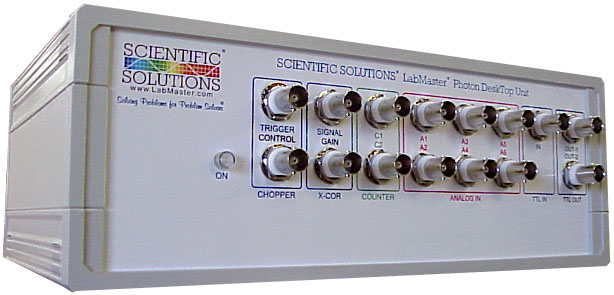
DeskTop PTI Front View - shows BNC connections
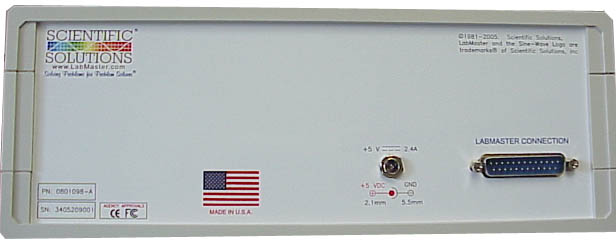
DeskTop PTI Back View - shows computer and power supply connections
Description of the LabMaster DPCI for PTI Felix Product
The Scientific Solutions LabMaster DPCI for PTI Felix was designed especially for customers of Photon's PTI Felix software who are currently running using the LabMaster DMA / ISA card but desire to run the software on a newer computer that has PCI slots.
We created a small PCI card that installs in your modern PCI computer. Along with the newer small PCI card, Scientific Solutions also provides a new DeskTop unit, that conveniently connects to the PCI card with a single quick-connect round cable replacing the several ribbon cables of the ISA design. On the front of the DeskTop unit are the familiar standard BNC connections that you are use to with your current BNC unit. This new unit has a sleek modern look on the outside, and custom electronics on the inside to completely replicate the circuits of the older BNC unit - but with modern reliable high-tech circuits.
Install the card and connect to the Desktop unit, install and configure your Felix software, and connect your equipment to the BNC connections and you are off and running!
The LabMaster DPCI product consists of two main items:
- The LabMaster DPCI computer interface which is installed a PCI slot of the computer
- DeskTop unit that contains the BNC connections and circuitry away from any internal computer noise.
In this configuration, the DeskTop unit contains BNC connections that are configured particularly for the PTI Felix software. This allows current ISA customers to easily migrate to a PCI based solution by unplugging the signal connections from their older PTI DeskTop unit and connect them to the new Scientific Solutions PTI DeskTop unit.
The DeskTop unit has the following BNC Connections on the front:
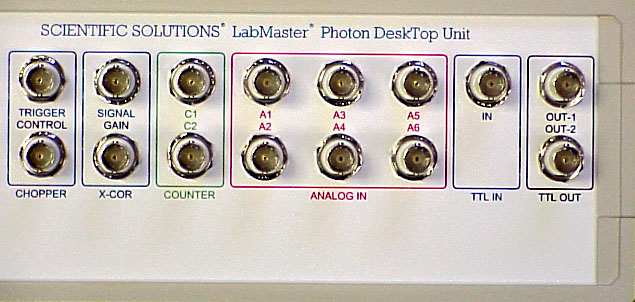
Close-Up Front View of DeskTop unit
- Chopper
- Trigger (input)
- Control (output)
- X-COR (also called RCQC)
- Signal (input)
- Gain (output)
- Counter (also called PMT)
- C1 (also called A Chan) (input)
- C2 (also called B Chan) (input)
- Analog In (also called Shutter)
- A1 (also called S1) (input)
- A2 (also called S2) (input)
- A3 (input)
- A4 (input)
- A5 (input)
- A6 (input)
- TTL In (also called Ext. Trig.)
- In (input)
- TTL Out (also called Detectors)
- Out-1 (also called a) (output)
- Out-2 (also called d) (output)
On the back of the DeskTop unit is a DB25 connection that provides Digital I/O connections.
Also on the back of the DeskTop unit are connections for the LabMaster DPCI computer interface and for the power supply. The LabMaster connection is a DB25 pin connector. The LabMaster DPCI DeskTop unit requires a 5v power supply that is also provided as part of the product.
All of the data acquisition circuits A/D, D/A, Digital I/O , Counter/Timer are external to the computer and are controlled by the LabMaster DPCI card in the computer using a single quick-connect round cable. The LabMaster DPCI is 100% register level compatible to the original PC LabMaster product introduced in 1981 and runs the Felix software perfectly!
LabMaster DPCI DeskTop Unit:
The DeskTop unit is about 11" wide x 7" deep x 4" high (280mm x 180mm x 100 mm). A light on the front of the DeskTop Unit illuminates to indicate the presence of power.
The LabMaster DPCI Card:
The LabMaster DPCI card is a small card that installs into a 32-bit PCI slot. It is approximately 2" x 4" (50mm x 100mm). The card has a single DB25 socket connector.
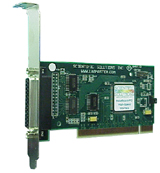
LabMaster DPCI PC Interface shown
Connecting the LabMaster DPCI and the DeskTop Unit:
To connect the LabMaster DPCI and the DeskTop Unit, use the following steps:
- Install the LabMaster DPCI card into your computer
- Attach the power supply (included) to the DeskTop unit.
- Connect the cable (also included) between the LabMaster DPCI card installed in the computer and the DeskTop unit.
- Turn the power ON to your computer.
- Now note that the light on the front of the DeskTop unit will illuminate when the power supply is attached and the computer is powered on. The DeskTop unit requires both the power supply to be connected AND the computer to be on in order to provide power to its internal circuits. The DeskTop unit automatically powers on when the computer is on and automatically turns off when the computer is off as a convenience for the user.
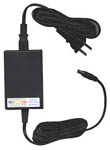
|
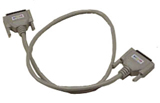
|
| DeskTop Power Supply (Included with Product) |
LabMaster DPCI to DeskTop Cable (Included with Product) |
Specifications subject to change without notice.
Scientific Solutions liability, trademarks, and export notices apply.
Copyright © 1972-2025 Scientific Solutions - All rights reserved.